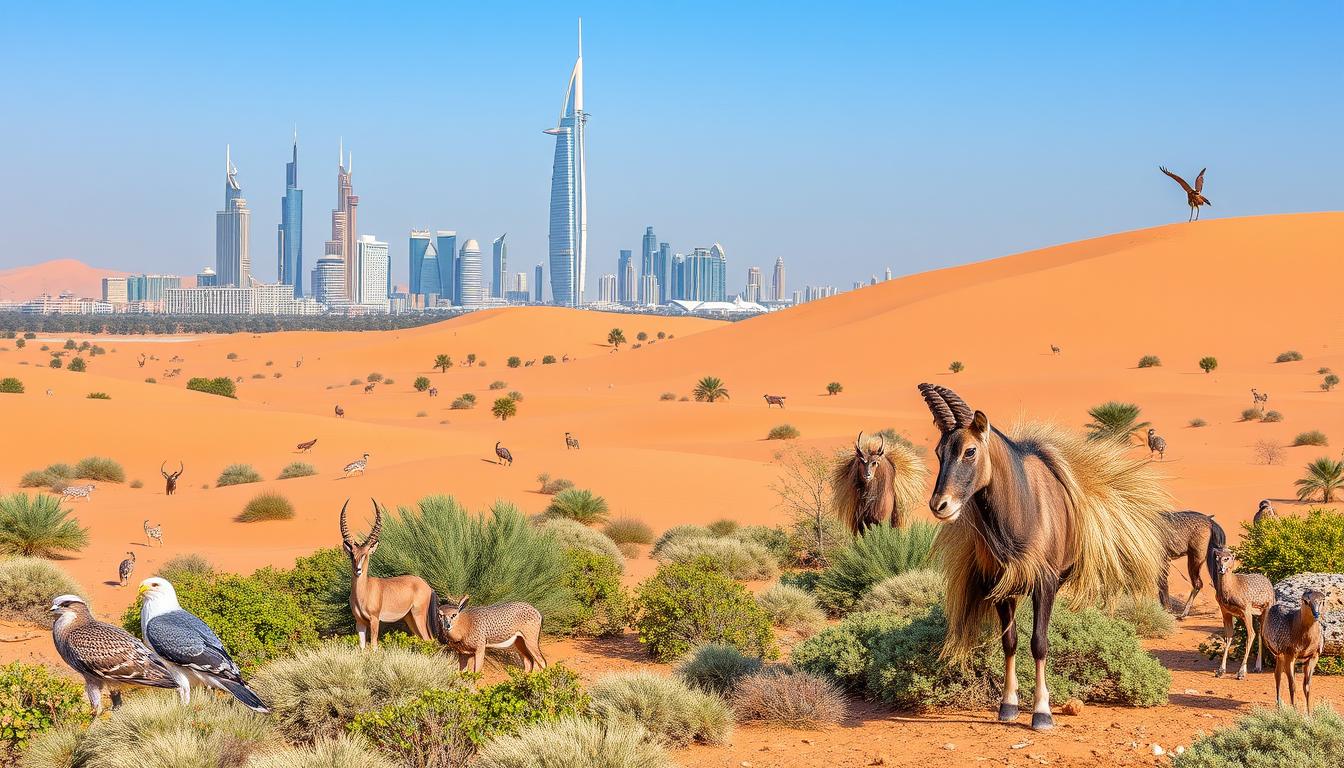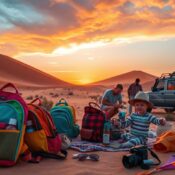Dubai’s Efforts in Wildlife Conservation: Protecting Nature in the Desert

Dubai’s Efforts in Wildlife Conservation: Protecting Nature in the Desert
Imagine being in the vast desert, where golden dunes stretch as far as you can see. The sun sets, painting the sky orange and pink. This beautiful, delicate place connects you to nature, showing why we must protect wildlife. In Dubai, efforts to save nature and its ecosystems are strong. Despite the city growing quickly, Dubai is committed to keeping biodiversity safe. They work hard to take care of and restore these areas for the future.
The Dubai Desert Conservation Reserve (DDCR) is a shining example of dedication to saving wildlife. It’s not only a home for unique species like the Arabian Oryx and Lappet-faced Vulture. It also shows Dubai’s leadership in global conservation. The reserve uses sustainable methods and new monitoring to keep a healthy balance between growth and taking care of the environment.
The more you learn about Dubai’s wildlife efforts, the more you see how important each step is. Small acts add up to help our planet thrive. Dubai works with its community and other countries to make a big difference. Their work in wildlife conservation is key for us all.
Key Takeaways
- Dubai Desert Conservation Reserve is the UAE’s first national park, showcasing commitment to wildlife conservation.
- The reserve is recognized as a candidate for the Green List, emphasizing sustainable nature-based experiences.
- Key species protected include the Arabian Oryx, Arabian Gazelle, and Lappet-faced Vulture.
- Innovative monitoring technologies such as drones are utilized for effective wildlife tracking.
- Dubai collaborates with international organizations like IUCN to enhance conservation efforts.
- Community engagement initiatives promote awareness of biodiversity preservation.
The Importance of Wildlife Conservation in Dubai
Dubai’s wildlife faces big challenges due to the city’s growt. The desert around it hosts many unique creatures. With deserts covering most of the UAE, it’s crucial to keep these areas safe.
By helping with wildlife preservation, we make sure animals and people can live together. The Mohammad Bin Zayed Species Conservation Fund has given $17 million to help over 1,200 species worldwide. The UAE leads in saving the ocean, getting high marks in the Global Environmental Performance Index.
- The UAE contains 731 plant species and 440 bird species.
- Over 30 Important Bird Areas have been identified to protect avian diversity.
- There are five falcon breeding centers contributing to the preservation of these birds.
Groups like the International Fund for Houbara Conservation work hard to protect wildlife. They breed endangered species and return them to the wild. This helps increase animal numbers and keeps Dubai’s natural beauty alive.
As cities get bigger, it’s important to find a balance with nature. Everyone in Dubai, from locals to visitors, needs to help protect the environment. Getting involved in conservation activities is key to a green future for all.
Understanding the Unique Ecosystem of the Desert
The Dubai desert is home to unique life forms. These life forms thrive despite tough conditions. Deserts cover more than one-fifth of the Earth. In the United Arab Emirates, deserts make up about 80% of the land. This ecosystem supports a variety of plants and animals, all adapted to survive in dry conditions.
The Ghaf tree, for instance, survives with very little rain—often less than 10 inches per year. Animals like the Sand Cat and Arabian Oryx have special ways to live in extreme heat and with little water. Keeping a diverse range of life in the desert is crucial for many ecosystems. It shows how species depend on their environment to survive.
Seasonal changes are important for desert life. The desert landscape transforms, showing new life after the rare rains. Places like the Dubai Desert Conservation Reserve protect many species. They are home to around 74 plant species and many mammals, reptiles, and birds.
But, unique ecosystems like Dubai’s face threats. Climate change and human activities harm the desert. Activities like off-road driving harm delicate areas. Also, taking too much groundwater is dangerous. We need to tackle these problems to save the desert’s biodiversity. This will let future generations enjoy this amazing place.
Dubai Desert Conservation Reserve: A Model for Wildlife Conservation
The Dubai Desert Conservation Reserve is a leading example of wildlife conservation in Dubai. It was established in 1999. Spanning 225 square kilometers, it makes up about 5% of Dubai’s total land area. This area represents a big step in saving habitats and endangered species in Dubai. It helps in recovery efforts vital for the region’s ecosystems.
History and Purpose of the Reserve
The reserve was created to protect the remaining desert wilderness in Dubai. It’s managed by the Emirates Group for Dubai’s Government. Over AED 28 million has been invested in it. This money supports its conservation work. The Visitor Centre shows the Reserve’s growth from 1999 until now. Guests can learn from thematic rooms such as the Nocturnal Hall and Habitat Hall.
Key Species Protected in the Reserve
In the reserve, important species like the Arabian Oryx, Arabian Gazelle, and Sand Gazelles are protected. The Arabian Oryx population has grown from just 230 to more than 1,300. Additionally, 2,800 Houbara, or Macqueen’s Bustard, have been reintroduced. This boosts the diversity crucial for long-term wildlife conservation in Dubai. The reserve is a haven for over 560 species of plants, birds, mammals, reptiles, and arthropods. It plays a key part in keeping the ecological balance and aiding habitat preservation.
Wildlife Conservation Dubai: Initiatives for Endangered Species
Dubai is key in saving endangered animals. The city works on special programs to help these animals survive. It uses rehabilitation and reintroduction to fight threats against them. This shows Dubai’s strong will to keep biodiversity safe.
Successful Reintroduction Programs
The Arabian Oryx is a big win for Dubai’s efforts. It was once gone in the wild but has come back. Thanks to Dubai’s focus, not just the oryx, but other animals too have returned to their homes. The work in wildlife rehab has helped endangered species increase their numbers. This is vital for them to keep living long term.
Monitoring and Research Efforts
It’s important to know how endangered animals live and act. Watching them closely gives researchers valuable information. In the UAE, 46.7% of mammals are at risk. So, research is ongoing to tackle their problems. Studies give insights that shape the conservation work. Partnering with groups like the Mohamed bin Zayed Species Conservation Fund also helps globally.
| Species Type | Percentage of Endangered Species | Notable Initiatives |
|---|---|---|
| Mammals | 46.7% | Reintroduction of Arabian Oryx |
| Reptiles | 19% | Monitoring programs for native species |
| Birds | 53% | Habitat restoration efforts |
| Plants | 8% | Documentation and protection of native species |
Dubai’s ongoing work shows its commitment to saving wildlife. It highlights the need to protect land and water habitats. Through teamwork and strong initiatives, Dubai is making a difference for endangered animals.
Habitat Restoration Efforts in Dubai
In Dubai, habitat restoration is key to promoting biodiversity and ecosystem health. It focuses on bringing back life to damaged areas, benefiting nature and people. Projects work on various ecosystems, like mangroves, which are crucial for the environment. These efforts combine ecosystem repair with local skills to achieve success.
Strategies for Ecosystem Rehabilitation
Key strategies for fixing ecosystems in Dubai include:
- Re-vegetation: Planting native species to rebuild natural areas.
- Soil protection: Steps to prevent soil erosion and keep it healthy.
- Community engagement: Getting locals involved in restoration to connect them with nature.
- Wildlife monitoring: Keeping an eye on wildlife to check ecosystem health.
A highlight project is planting 50,000 mangrove trees in the Northern Emirates. This moves the UAE to the forefront in mangrove expansion. Mangroves are vital for endangered animals and fight climate change by absorbing carbon.
Collaborations with Local Organizations
Habitat restoration in Dubai succeeds through partnerships with local groups and academics. These alliances boost restoration projects and help manage areas long-term. The Dubai Turtle Rehabilitation Project is a prime example. It has used education and conservation to release over 2,000 turtles back into the wild, enriching local wildlife.
Environmental Education and Community Engagement
Environmental education in Dubai is key for community engagement and building responsibility towards nature. Schools and communities have programs to educate on biodiversity importance. This kind of education sparks long-term dedication to environmental protection among young people.
Programs for Schools and Local Communities
Schools in Dubai offer important programs on environmental education. They teach students about the balance of ecosystems. Students enjoy field trips and projects like tree planting, connecting with nature.
Local communities get to join workshops. These workshops promote community engagement. They also provide tips on sustainable living.
Awareness Campaigns on Biodiversity Preservation
Dubai also runs campaigns on biodiversity. The goal is to teach people about preserving ecosystems. These campaigns unite everyone from businesses to NGOs in conservation work. Joining these efforts shows the power of teamwork in protecting wildlife and ensuring a sustainable future.
Sustainable Tourism in Dubai: Balancing Nature and Travel
In Dubai, tourism and wildlife conservation work together. Eco-friendly efforts are becoming more common. The Year of Sustainable Tourism and Development was 2017. This showed how important it is to travel in a way that protects our environment. Dubai’s approach to sustainable tourism helps keep the desert ecosystem safe.
Eco-friendly Initiatives for Tourists
Dubai has several eco-friendly measures to reduce tourism’s environmental impact. Platinum Heritage has won a Green Tourism Award from Dubai Tourism. This award proves their dedication to being eco-friendly. They focus on:
- Replacing Land Cruisers and Hummers every five years, saving 18 vehicles from being made and cutting down on waste.
- Getting all their energy from solar panels, using LED lights, and designing buildings that work with gravity.
- Not using disposable materials, which reduces the use of plastics and paper.
- Picking eco-friendly goods and managing waste well.
- Staying away from dune bashing to protect wildlife homes.
Impact of Tourism on Wildlife Conservation
Tourism can affect wildlife in different ways. It helps raise money and awareness for protecting nature, but it also challenges sustainability. Dubai’s Sustainable City shows the effort to blend environmental care into hotels. This move helps keep the area’s animals and plants safe. The Dubai Desert Conservation Reserve also protects wildlife while letting visitors enjoy the desert.
We must understand tourism’s role in both supporting and threatening wildlife. By linking tourism with green goals, we can save the desert’s wonders. This way, travel experiences remain beautiful and respectful to nature.
| Initiative | Description |
|---|---|
| Green Tourism Award | A recognition awarded to Platinum Heritage for its sustainable safari practices. |
| Renewable Energy | 100% energy sourced from sustainable methods, including solar power. |
| Vehicle Replacement Strategy | Every five years, vehicles are replaced to reduce manufacturing waste. |
| Waste Management | Strict protocols to eliminate single-use materials and manage waste effectively. |
| Desert Conservation Reserve | A vital area for wildlife, supporting both conservation and tourism activities. |
The Fight Against Illegal Wildlife Trade in Dubai
Dubai has made fighting illegal wildlife trade a top goal. This issue grabs both national and international focus. Efforts bring together various groups to stop the trafficking routes endangering animals. This includes better teamwork between customs, law enforcers, NGOs, and global organizations.
Collaboration with National and Global Organizations
Working with groups like CITES helps develop strong tactics against wildlife trafficking. The UAE has been active in this fight. Efforts include:
- Training programs that boost government officials’ knowledge on wildlife laws and the trade’s complexity.
- Campaigns that show why protecting wildlife matters and the legal troubles from trafficking.
- Efforts with Emirates SkyCargo, setting a strict rule against illegal wildlife trade, like banning hunting trophies.
Training for Customs Officers and Airlines
Training customs officers and airline staff is key in stopping wildlife smuggling. They learn to spot potential smuggling tries through:
- EWS-WWF and CITES workshops, which supply the right skills and info.
- Spying techniques to watch for fishy behavior at airports and borders.
- Tips on identifying endangered animals and illegal wildlife items.
Since 2017, these trainings have helped catch many illegal shipments. This shows UAE’s dedication to stopping animal trafficking through CITES partnerships.
| Initiative | Description | Impact |
|---|---|---|
| Training Programs | Workshops for customs officials and government personnel | Enhanced ability to identify and combat illegal trade |
| Public Awareness Campaigns | Efforts to educate the public about wildlife protection | Increased public participation in combatting wildlife trafficking |
| CITES Collaboration | Engagement with international wildlife protection agreements | Streamlined and effective wildlife trade regulations |
| Zero-Tolerance Policy | Prohibition of illegal wildlife transport by Emirates SkyCargo | Successful interception of several illegal shipments |
Future Challenges and Opportunities for Wildlife Conservation
The future of wildlife conservation in the UAE is twofold, presenting both challenges and chances for growth. Climate change brings significant threats to wildlife. This means it affects the health of ecosystems. In Dubai, the rise of urban development makes these problems worse. Species are pushed to the brink, fighting for survival in shrinking habitats.
Climate Change and its Impact on Biodiversity
Climate change is altering ecosystems in Dubai. It affects plants and animals on land and in the sea. As cities grow, habitats disappear. The UAE hosts over 800 plant species and numerous animals. But less than 10% of wildlife conservation efforts are noted in official plans. Only about 3% of these plans mention funding. To fight climate change, it’s crucial to protect key areas. Mangroves and coral reefs are vital. They help capture carbon and support many life forms.
Innovative Approaches to Conservation in the Region
But there is hope with new ways to tackle conservation challenges. Raising awareness and educating people are key to valuing nature. Technology also plays a big role. It helps us watch over biodiversity and conserve it better. Using smart tech to follow animal movements helps. It also gets people involved in safeguarding nature.
Money from abroad is important too. Countries in the Global South can use their nature to fight climate change. Linking the economy to wildlife conservation could keep ecosystems healthy. This works even as cities get bigger. Cooperation is essential. Governments, local groups, and global partners working together can make big conservation plans happen.
| Challenge | Impact | Opportunity |
|---|---|---|
| Climate Change | Habitat loss and biodiversity decline | Adoption of innovative conservation strategies |
| Urban Development | Increased threats to wildlife | Smart technology for monitoring ecosystems |
| Funding Limitations | Slow progress on conservation commitments | New financial mechanisms for wildlife protection |
| Public Awareness | Lack of community involvement | Education programs to engage residents |
Dubai faces complex issues in wildlife conservation. Yet, with innovative and united efforts, we can aim for a sustainable future. This future would support both wildlife conservation and the varied ecosystems around the region.
Conclusion
The adventure of wildlife conservation in Dubai is a colorful story. It shows how the government, local folk, and groups work together to protect nature. Together, they build programs and reserves. These efforts help save unique animals and plants. They also teach people why it’s key to conserve wildlife in Dubai.
Thinking about the future, we see new tech like the Sign4L High Power IMSI Catcher leading the way. It fights against illegal hunting. This tool watches over protected areas closely. It can quickly react to dangers. At the same time, it makes sure people’s privacy rights are respected.
The dedication to saving wildlife in Dubai is for the long haul. It’s building a lasting heritage. By choosing eco-friendly ways and tourism, you help protect the area’s rich animal and plant life. Every person has the chance to make a lasting difference. Let’s all help care for Dubai’s unique and fragile earth.
FAQ
Why is wildlife conservation important in Dubai?
Wildlife conservation helps keep Dubai’s nature in balance. It protects animals that are in danger of disappearing. This work also keeps Dubai’s unique desert life safe for future generations.
What makes Dubai’s desert ecosystem unique?
Dubai’s desert is home to plants and animals that have adapted to tough conditions. Limited water and changing seasons affect their survival. This makes conservation work key.
What is the Dubai Desert Conservation Reserve?
The Dubai Desert Conservation Reserve was the first national park in the UAE. It works to save the natural desert area of Dubai. The reserve focuses on bringing back local animals and plants, like the Arabian Oryx.
How does Dubai support endangered species?
Dubai has programs to return endangered animals like the Arabian Oryx to the wild. These efforts are helped by research and keeping an eye on animal numbers. This helps animals make the most of their habitats.
What strategies are involved in habitat restoration in Dubai?
Restoring habitats in Dubai includes planting more greenery and protecting the soil. Working together with local groups and schools helps make these efforts better. This approach aims to manage land in a way that is good for all living things.
How does environmental education contribute to wildlife conservation?
Environmental education in Dubai gets the community and schools involved in nature care. Campaigns that raise awareness are key. They show how we all can help in saving our wildlife and places.
What eco-friendly initiatives does Dubai offer to tourists?
Dubai has eco-friendly options for tourists that help in saving nature. Traveling responsibly lessens harm to our planet. It also helps protect local animals and their homes.
What measures are being taken to combat illegal wildlife trade in Dubai?
To fight illegal wildlife trade, Dubai works with groups around the world. Training is given to customs and airline workers. This improves their ability to stop animal trafficking, keeping rare species safe.
What are the future challenges for wildlife conservation in Dubai?
Challenges like climate change and growing cities threaten wildlife in Dubai. Yet, new tech and cutting-edge conservation can create hope. They promise a brighter future for wildlife protection in the area.




